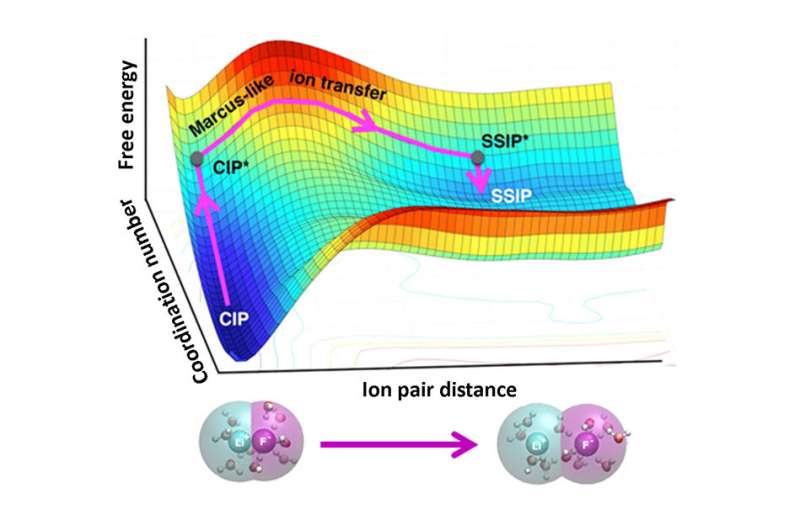The separation (bottom) of lithium fluoride (Li and F) ion pairs involves two stages: (1) an increase of the water coordination about the ions (contact ion pairs, CIP to CIP*) and (2) spatial separation of the ions (CIP* to solvent-separated ion pairs, SSIP*). As the top chart shows, the free energy is dominated by the process of solvent rearrangement like the Marcus theory of electron transfer. Credit: American Chemical Society
Inside fuel cells, batteries, and biological systems, pairs of ions in water can affect chemical reactions. Knowing more about how water influences those reactions could be helpful. Theorists designed a simple, elegant method that explains the influence. Their method shows how water moves around ions and causes them to draw together or stay apart.
Ion pairing can be an important factor in chemical and biological processes. Joining ions involves complex motions of networks made of water molecules. The team's approach offers insights into ions and how they pair. The results will let scientists predict, control, and tune structure, function, and dynamics of ions and related processes.
The association or dissociation of ion pairs in water is present in chemical reactions in fuel cells, batteries, and human cells. Scientists have struggled to understand how water molecules that cluster around the ions influence the reactions. The challenge? Traditional computational models often contain too much information to reveal the desired features. A team of theorists designed a simple, elegant method that shows how water moves around pairs of ions and influences whether they draw together or stay apart. To develop the theory for ion pairs, the team explored the distance between the ions and the number of water molecules around either the individual ion or the ion pair.
Applying the approach, the team revealed that ion dissociation occurs in two stages. First, there is an increase in the number of water molecules around each ion. Second, the ions move apart. For ions to join together, water molecules must move out of the way. Water moving is the critical, rate-limiting step. The team's framework draws from Marcus theory, originally designed to calculate how fast electrons transfer between molecules in solutions and later extended to other transformations. The team's method offers an improved understanding of ion pairs that will let researchers control and tune structure, function, and dynamics of ion pairs in different systems, from proteins' interactions with DNA to ions' motion in batteries.
More information: Santanu Roy et al. Marcus Theory of Ion-Pairing, Journal of Chemical Theory and Computation (2017). DOI: 10.1021/acs.jctc.7b00332
Provided by US Department of Energy






















